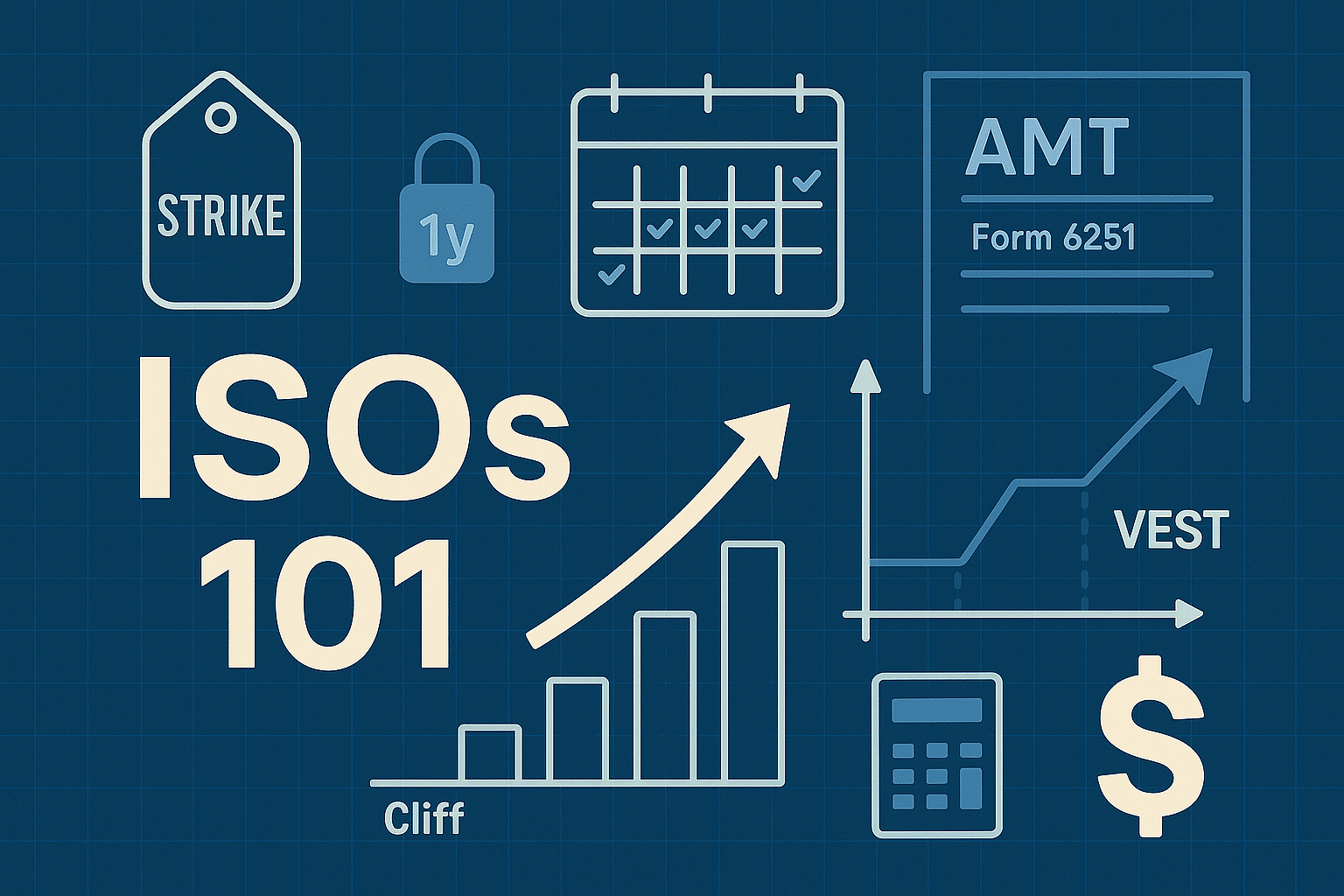If part of your compensation package includes incentive stock options (ISOs), you’ve been granted the option to purchase company stock at a set price. This type of option can unlock a major upside with preferential tax treatment, but only if you understand how the rules work.
ISOs also come with potential pitfalls—like alternative minimum tax (AMT) exposure and concentration risk—that require careful planning. This guide explains how ISOs function from grant to sale, how the tax rules actually play out, and the choices you’ll face along the way.
What Are ISOs, in Plain English?
Incentive Stock Options (ISOs) are a type of equity compensation that lets you purchase company shares at a fixed “exercise price” (aka the strike price, or the price you’ll pay to buy each share). Unlike receiving stock directly, ISOs are only a right—you decide whether to buy, and the value comes from the gap between your exercise price and the stock’s fair market value. If your company grows, that difference can become a significant source of wealth.
The process starts with a grant, which outlines how many options you receive, the strike price, and the expiration date (typically 10 years from grant). Over time, the options vest, meaning you gradually earn the ability to exercise them. Once vested, you can exercise—buying shares at the strike price. From there, it’s up to you whether to hold the stock for potential long-term tax benefits or sell sooner to lock in liquidity.
Your outcome hinges on the timing of the sale. Hold long enough, and most of your profit may qualify for favorable capital gains treatment. Sell too soon, and part of that profit is taxed as ordinary income. This difference makes ISOs powerful, but also more complex than other forms of compensation.
How ISOs Move From Grant to Sale
The journey of an ISO moves through several distinct stages, each with its own rules and potential tax effects:
Step 1) Vesting: Vesting is the schedule that dictates when you gain the right to use your options. Many companies require a one-year “cliff” before any shares vest, after which additional portions unlock every month or quarter. Until options vest, you can’t exercise them.
Step 2) Exercising: Exercising means buying company stock at your strike price. This step requires cash for the purchase itself. Once exercised, you can decide whether to sell immediately for liquidity or hold on to the shares in hopes of more favorable tax treatment later.
Step 3) Selling: To receive long-term capital gains tax rates on your profits, you must sell your shares a minimum of two years after the grant date and one year after exercising. Failing to meet these conditions results in a disqualifying disposition, where a portion of your profit is taxed as ordinary income.
Step 4) Expiration: ISOs don’t last forever. They typically expire 10 years from the grant date, but if you leave your company, the window often shrinks to just 90 days. Miss this deadline, and you lose the ability to exercise entirely.
ISO Taxation — Regular vs. AMT
Taxes on ISOs can follow one of two paths, and the difference between them can have a big impact on your outcome:
Regular Tax System: Under the standard rules, exercising your ISOs and holding on to the shares doesn’t create an immediate tax bill. Taxes on the stock are only due upon its eventual sale. To qualify for long-term capital gains, which are typically taxed at lower rates than ordinary income, you must hold the shares for at least two years from the grant date and one year from the exercise date.
Alternative Minimum Tax (AMT): The AMT is a separate tax system designed to ensure that high-income individuals pay a baseline level of tax. When you exercise ISOs and retain the shares, the difference between your strike price and the stock’s fair market value is considered income for AMT calculations. This is true even if you haven’t sold the shares or received any cash. This is often called “phantom income.” AMT does not always apply—it only comes into play if the phantom income plus your other earnings pushes you above the AMT exemption amount.
AMT Credit: If you do end up paying AMT, it’s not always permanent. You may qualify for an AMT credit, which can be used in future years to reduce the amount of regular income tax you owe once your situation changes. The catch is that it can take years to fully use the credit, and the timing depends on your income and how much tax you generate under the regular system going forward.
Please Note: Because AMT depends on your income, timing, and the company’s stock value, it can be difficult to predict on your own. For significant ISO exercises, consulting a financial advisor or tax professional is recommended to model potential outcomes and prevent unexpected issues.
Public vs. Private Company ISOs
The stage of your company shapes how much flexibility you have with ISOs. Here are the primary differences between public and private company ISOs:
Public companies: You have visible market prices and can usually exercise and sell in the same day, or hold with the comfort of knowing there’s liquidity when you need it. Trading windows, insider restrictions, and price volatility still need to be managed.
Private companies: Liquidity may be years away, and the stock’s value is often determined by a 409A appraisal rather than daily market trading. Tender offers or initial public offerings (IPOs) become the only opportunities to sell. Early exercise with an 83(b) election can make sense when the spread is small, but it carries risk if the company never goes public or declines in value.
Planning Considerations That Add Value
The success of your ISO strategy often depends less on the options themselves and more on the decisions you make around them. A few key areas deserve extra attention:
Cash flow: Exercising ISOs requires upfront capital — not just to purchase the shares, but potentially to cover taxes triggered by the exercise. If liquidity is tight, you might be forced into an early sale that negates ISO tax benefits. Planning ahead for both purchase and potential AMT liability gives you room to choose your timing strategically rather than reactively.
Tax modeling: Before you exercise, detailed projections can reveal whether AMT will come into play and how it could affect your cash position. Modeling different exercise dates, stock values, and sale outcomes helps you identify thresholds where AMT might be triggered — and where staggered exercises could reduce the hit.
Portfolio balance: While ISOs can grow into a meaningful part of your wealth, they should remain one component of a diversified portfolio. Instead of focusing on “how much company stock is too much,” think in terms of how those shares fit into your overall goals, time horizon, and risk tolerance. Periodically trimming or diversifying proceeds after vesting helps manage exposure without undermining your confidence in your employer’s prospects.
Coordination with other benefits: ISOs often overlap with RSUs, employee stock purchase plans (ESPPs), or annual cash bonuses. Aligning exercise timing with these other benefits can smooth income across years, reduce the chance of multiple tax events at once, and better match your equity activity with your personal cash-flow needs.
Common ISO Pitfalls to Avoid
There are several traps ISO holders fall into. Being aware of the following ahead of time can help you sidestep costly mistakes:
Exercising at year-end: Many people exercise in December without running AMT calculations first. This can lead to an unexpected tax bill in April, since the timing gives you no chance to adjust or spread liability across multiple tax years.
Overlooking the 90-day rule: After leaving a company, you generally have only 90 days to exercise vested ISOs before they expire or convert into non-qualified stock options (NSOs), which carry less favorable tax treatment. Missing this window can erase your opportunity altogether.
Overconcentration in employer stock: Holding too much of your net worth in company shares exposes you to unnecessary risk. A downturn in the stock can affect both your job security and your portfolio at the same time.
Missing the 83(b) deadline: If you exercise early, you must file an 83(b) election within 30 days. There are no extensions. Missing this filing means you lose the tax advantages of starting the holding period early.
Assuming taxes are withheld automatically: Unlike restricted stock units (RSUs) or regular wages, ISOs don’t have built-in payroll withholding. If you owe tax from exercising or selling, it’s your responsibility to make estimated payments. Failing to plan for this can leave you short at tax time.
Quick Recap: ISO Exercise Strategies
There are several ways to approach exercising your ISOs, each with different timing, tax, and liquidity considerations. Understanding these trade-offs can help you align your choice with both your financial goals and your risk tolerance:
Exercise-and-sell (same day): This approach lets you buy and sell your shares immediately, eliminating AMT exposure since you don’t hold the stock past year-end. It’s straightforward and provides instant liquidity, but you’ll forfeit the preferential ISO tax treatment because the sale counts as a disqualifying disposition. For many employees, it’s a practical choice when cash flow or diversification is the top priority.
Exercise-and-hold: By holding the shares after exercise, you position yourself for long-term capital gains if you meet the holding period requirements. The trade-off is that you’ll need enough cash to cover both the purchase and potential AMT liability, without knowing how the stock will perform in the meantime. If the price drops, you could owe taxes on paper gains that no longer exist — making this strategy best suited for those confident in their company’s long-term growth and able to absorb short-term volatility.
Staggered exercises: Instead of exercising everything at once, you can spread purchases across several tax years. This helps manage cash demands and smooth out AMT exposure, allowing you to test the tax and performance impact gradually. It requires more recordkeeping and discipline, but it’s often a balanced approach for employees with a large option grant or uncertain liquidity timeline.
Early exercise with 83(b): Some companies offer the ability to exercise your options early, even before they vest. Filing an 83(b) election within 30 days of exercising lets you start the holding period right away, while the spread between strike price and fair market value is minimal — reducing or eliminating AMT. The upside is starting the tax clock early, but the risk is that you could pay for shares that lose value or never become liquid if the company stays private or underperforms.
Incentive Stock Options (ISOs) FAQs
When do ISOs trigger Alternative Minimum Tax (AMT)?
AMT generally comes into play in the year you exercise your ISOs and hold onto them beyond December 31. The “bargain element,” which is the gap between your exercise price and the stock’s fair market value on that date, is included in your income for AMT calculations.
This is the case even if you haven’t sold the shares or received any cash yet. This phantom income can create a significant tax bill, especially if you exercise a large number of options at once or your company’s stock value is high.
How do I qualify for long-term capital gains?
To receive long-term capital gains treatment, your sale must be a qualifying disposition. That means holding your shares for at least two years from the grant date and one year from the exercise date.
Meeting both timelines ensures that your profit — the difference between the sale price and your exercise price — is taxed at favorable long-term capital gains rates rather than as ordinary income. Missing either holding period results in a disqualifying disposition, which increases your tax rate on part of the gain.
What happens if I sell in the same year I exercise?
Selling in the same calendar year that you exercise results in a disqualifying disposition, which means the AMT preference is effectively canceled. The difference between your exercise price and the stock’s fair market value on the day you exercise is considered ordinary income. Any profit or loss beyond that is treated as a capital gain or loss. While you lose potential long-term tax benefits, this approach can simplify your tax situation and eliminate AMT exposure altogether.
What happens to my ISOs if I leave the company?
After leaving your employer, you generally have a 90-day window to exercise vested ISOs if you want to keep their tax-advantaged status. After that period, the options typically convert to non-qualified stock options (NSOs) or expire entirely, depending on your company’s plan rules. Some employers may offer extensions or exceptions in cases like disability or retirement, so it’s wise to review your equity agreement before making any decisions.
Do payroll taxes apply to ISOs?
Under the regular tax system, no Social Security or Medicare (FICA) taxes apply to the spread when you exercise ISOs. However, if the holding period requirements are not met before selling the stock, a portion of your gain will be classified as ordinary income and may be reflected on your Form W-2.
While payroll taxes still don’t apply to that portion, you’ll owe regular income tax on it. Keeping detailed records of your exercise and sale dates helps ensure your reporting is accurate.
Is early exercise with an 83(b) election worth it?
An early exercise followed by an 83(b) election can be advantageous if your company’s stock value is low and you expect significant future growth. Filing within 30 days of exercise allows you to pay taxes (if any) on a minimal spread, start the long-term holding clock immediately, and potentially reduce or avoid AMT later.
The downside is that you’re paying for unvested shares upfront — and if the company’s value declines or you leave before vesting, you could lose that investment. Because outcomes vary widely, it’s best to evaluate this move with your tax advisor before filing.
We Can Help You Make the Most of Your ISOs
ISOs can be a powerful wealth lever, but the payoff depends on timing, taxes, and liquidity. We help you turn the moving parts into a clear action plan: modeling AMT before you exercise, mapping cash needs, and choosing when to sell or hold based on your goals—not guesswork.
You’ll know exactly which shares qualify for long-term rates, how staggered exercises change your tax picture, and where an 83(b) or post-termination 90-day window fits in. We’ll coordinate directly with your CPA or attorney—or introduce trusted pros—so tax filings, elections, and deadlines don’t slip through the cracks.
If you want a straightforward path from grant to sale with fewer surprises, we’re ready to help you pick the right strategy and execute it step by step.












